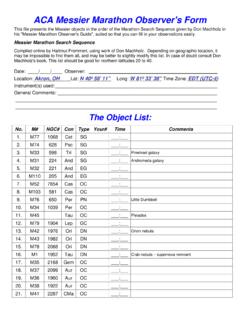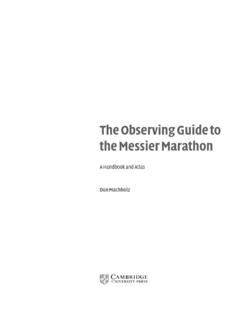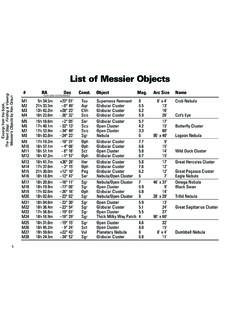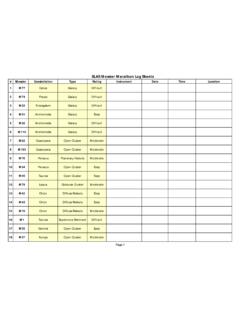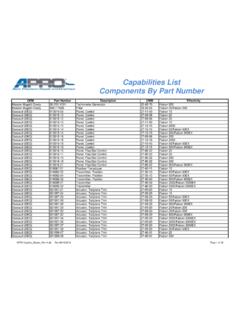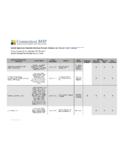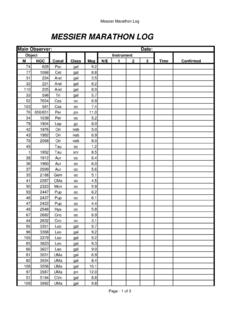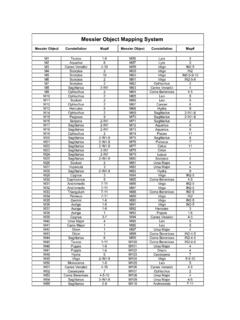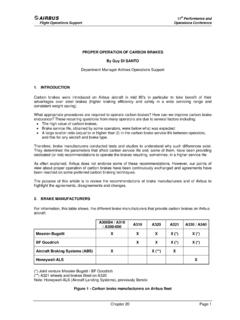Transcription of JIT Flow Simulation AKA: The “Paper Airplane” Exercise
1 JIT Flow Simulation AKA: The paper Airplane Exercise This is a simple, but powerful, teaching tool that allows the demonstration of nearly every JIT principle and gives an opportunity to discuss the rest. The power is in the flexibility of the Exercise to be adapted and modified to nearly any circumstance. These instructions are not intended to be in any way prescriptive. They are, however, an effective and proven baseline from which to operate. Required Number of Participants Operators 4 Expediter/Material Handler 1 Factory Manager 1 Customer 1 Timers 2 1 Basic Exercise (45 - 60 minutes, use in SIM, most AIW situations) Materials: 60 sheets plain paper 20 sheets 3 punch paper 10 sheets colored paper 2 stopwatches 1 calculator flip chart two contrasting color markers Preparation: Pre-build four production station sets: 1.
2 Two sheets plain (unfolded paper ), one w/ fold #1. 2. Two sheets w/ fold #1; one with folds #1, #2. 3. Two sheets w/ fold #1, #2; one with folds #1, #2, #3. 4. Two with folds #1, #2, #3; one completed airplane. Fold #1 (Op #1) Fold #2 (Op #2) (two folds) Fold #3 (Op #2) (two folds) This edge ends up aligned with winglet - bottom edge ends up along top edge. Fold #4 (Op #4) (two folds each side, four folds total) 2 Note: As silly as it seems, there is a reason for the folds illustrated. Using this design ensures that there is a big enough work imbalance to make some important teaching points, especially in the advanced variation at the end of this document. On a flip chart, draw the following matrix: Lot Size WIP Throughput (Lead) Time Total Run Time Deliveries (to customer) # of people Space Productivity (Units / Person / Minute) Quality Comments, Observations Set up the Exercise .
3 This should be fun, not dry. Run #1 Announce that we are going to demonstrate the differences between various production systems by setting up a factory that makes airplanes . Ad lib something about the airplanes we are making. (they don t fly, etc.) Ask for a volunteer for operator #1. Point out that this job requires some skill and precision. When someone volunteers, give them production station set #1. Make a flourish out of demonstrating how to fold the paper , ask if they understand, then ask them to practice on the remaining sheet. They should now have three completed sheets for Op #1. Finished Plane 3 Repeat the process for operators #2, #3, and #4. Be sure to solicit volunteers from different tables, preferably criss-crossing the room several times. Solicit a volunteer to be the materials handler. A good technique if no one is forthcoming is to see if anyone is wearing athletic shoes and volunteer them.
4 Explain to the material handler that his job is to move material from operation 1 to operation 2; from operation 2 to operation 3, from operation 3 to operation 4 and from operation 4 to our customer. The customer can either be another student volunteer or a co-instructor. There is some advantage to using a co-instructor as customer. There is less briefing involved and co-instructors are generally more willing to be a pain to the factory manager when their deliveries are late. Quietly brief the customer to take any but obviously misfolded airplanes , but to object loudly if any of the airplanes made from defective material should be delivered to him. Make sure the customer knows what defective material is. (Another good reason to use a co-instructor as customer.) Appoint a factory manager. Make it clear that the factory manager s job is to keep things running smoothly and keep the customer happy.
5 Don t let the factory manager help out. Timers: If you are using stopwatches, you can keep time yourself, or appoint people to do it. Point out that because of the distance between operations, we are building and moving materials in lots of three airplanes . They can move any multiple of three that are ready, but lots of three must stay together. Tell the operators that once they have completed three parts, they are to call for the material handler to take their work to the next operation. They should not wait for the material handler, though. If they have work queued up, they need to keep working. Announce that everyone else in the class is a wastologist, someone schooled and studied in the science of waste. They are to identify specific examples from the Closed mitt list and write them down for the debrief. Tell them that once the system is running smoothly you will introduce a different color sheet of paper to track how long it takes product to move through the system.
6 They are to treat that sheet like any other. The customer will take all of the airplanes they can build. You (the instructor) will supply raw material to the first operation. Ask if there are any questions. Do not allow them to change the production layout, etc. Only answer questions about how the factory will operate. Announce Go! and start the production run timer. 4 Be sure to feed paper to Op #1 as fast as he needs it. If the operator makes an improvement and starts folding three sheets at a time, praise him for his improvement, but don t mention it unless he thinks of it. Operation #2 and operation #4 should back up fairly quickly. Once there is significant WIP backed up in the system, introduce the colored sheet of paper . Start the throughput (lead) time timer as soon as the operator touches the stack. At this point, the customer should begin bothering the manager about when the colored airplane will be delivered.
7 (This is to point out schedule stability later.) Start slipping defective raw material into the stack. If operator #1 is folding three at a time, start by sandwiching the defective material between two good sheets, then intermix stacks with no defects, one, two, or three defects. If the operator says something try to not respond at all - sometimes their comments are just to someone else at the table. If they get the factory manager or attempt to stop production, tell them that s the material you have. Try to keep it as low-key as possible. (Note: An alternative for defective material is to take a stack of paper , drive a staple through one corner and pull it out. This leaves very subtle defects.) At some point the students usually start expediting the colored airplane. Let them, but insist it always move as part of a group of three units.
8 If they do expedite, let them. It s a good teaching point later. When the customer gets the colored airplane, stop the Exercise , and note the flow time for the colored plane. Debrief (Chart filled in with example, but typical, numbers. Obviously you use the real ones.) Fill in Run #1 at the top. Our lot size was three Ask everyone to count up how much WIP they have. Don t count delivered airplanes or raw material. Total it up and enter the number in WIP. If it doesn t divide by 3, have some fun about how THAT could happen. Run #1 Lot Size 3 WIP 32 Total Run Time 7:15 Throughput (Lead) Time 6:32 Deliveries (to customer) 18 # of people 6 Space 4 tables Productivity Quality 12 Comments, Observations 5 Ask the timer (or announce if you kept time yourself) how long it took the colored airplane to flow through the system.
9 If they expedited the colored plane, point out that this is the expedited time! Ask the customer how many airplanes were delivered. Remind the class that we had four operators, a material handler and a manager for a total of six people. Say we used four tables, so that s good for the space and write 4 in the space box. Calculate productivity. Tell the class we will measure productivity as planes per person per minute. Divide the number of planes delivered to the customer by six (people). Divide that result by the total start to finish time of the Exercise . This number is typically between and Note: For calculation ease - six seconds = minutes. :06 seconds = minutes :12 seconds = minutes :15 seconds = minutes :30 seconds = minutes :45 seconds = minutes Ask permission from the class to round the minutes for calculation so they know what you are doing when the numbers look different.
10 Ask about quality. Hold up a piece of defective material and ask how many pieces are in the system. The class will have to go through a mad search to locate and find the pieces with defective material. Point out how much time and effort they are spending and ask them how often they go through this Exercise in real life when they discover a problem. Write the number of defects in the box. Ask everyone What was it like to work here? Try to facilitate the group through understanding: Stress, chaos, no communication, didn t know how much work to do, etc. Ask the wastologists what they observed, record their comments on the flip chart. Ask them where the bottleneck is in the process. Most will agree it is either operation #2, operation #4 or both. Run #2 Ask the class what we can do to fix some of the problems. They will nearly always suggest putting the operations closer together.
